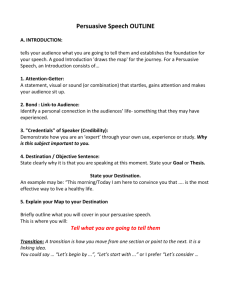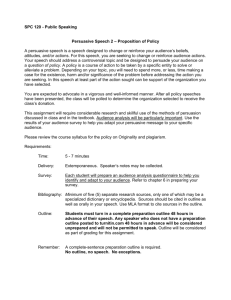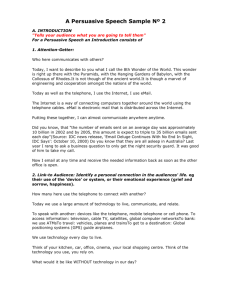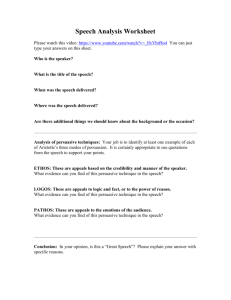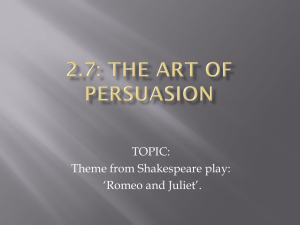What is a Persuasive Speech?
advertisement
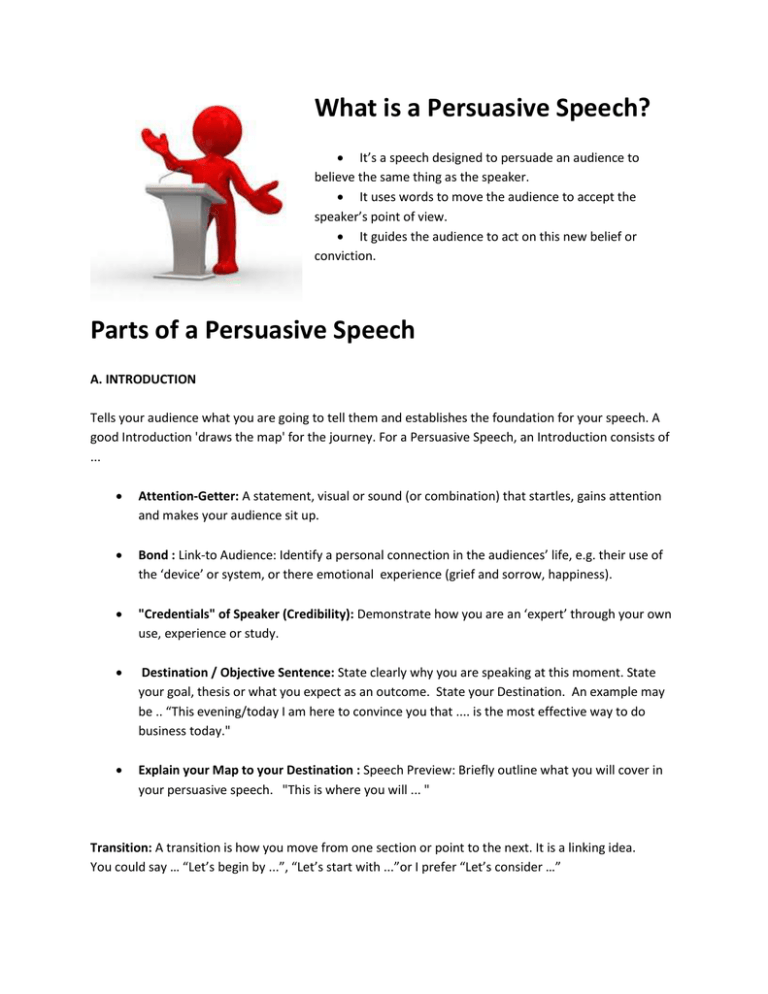
What is a Persuasive Speech? It’s a speech designed to persuade an audience to believe the same thing as the speaker. It uses words to move the audience to accept the speaker’s point of view. It guides the audience to act on this new belief or conviction. Parts of a Persuasive Speech A. INTRODUCTION Tells your audience what you are going to tell them and establishes the foundation for your speech. A good Introduction 'draws the map' for the journey. For a Persuasive Speech, an Introduction consists of ... Attention-Getter: A statement, visual or sound (or combination) that startles, gains attention and makes your audience sit up. Bond : Link-to Audience: Identify a personal connection in the audiences’ life, e.g. their use of the ‘device’ or system, or there emotional experience (grief and sorrow, happiness). "Credentials" of Speaker (Credibility): Demonstrate how you are an ‘expert’ through your own use, experience or study. Destination / Objective Sentence: State clearly why you are speaking at this moment. State your goal, thesis or what you expect as an outcome. State your Destination. An example may be .. “This evening/today I am here to convince you that .... is the most effective way to do business today." Explain your Map to your Destination : Speech Preview: Briefly outline what you will cover in your persuasive speech. "This is where you will ... " Transition: A transition is how you move from one section or point to the next. It is a linking idea. You could say … “Let’s begin by ...”, “Let’s start with ...”or I prefer “Let’s consider …” B. BODY OF YOUR SPEECH The body of your speech is where the detail is found and is best contained in THREE points (you can have more, but don't confuse your audience). For a Persuasive Speech, this is where you will ... “Tell them” Main Point #1 State Point 1 State a Reason Give an Example Restate the Point Transition: Create a linking statement to Point 2 Main Point #2 State Point 2 State a Reason Give an Example Restate the Point Transition: Create a linking statement to Point 3 Main Point #3 State Point 3 State a Reason Give an Example Restate the Point Transition: Create a linking statement to the Conclusion, eg “Let’s summarize ..." or “Can we consider these main points ..." C. CONCLUSION “Tell them what you have told them” Restate thesis Restate main points Call-to-Action: e.g. “I encourage you to …”, “Let’s all contribute …” , “… sign now …”, “make a decision now to be involved …” This Persuasive Speech Outline is exceptionally powerful. Use it to write YOUR speech. Persuasive Speech Checklist My speech has a strong topic sentence. My speech has a minimum of three supporting sentences. My speech has a strong concluding sentence that calls someone to take action. All of the sentences in my speech are related to the topic. All of the ideas in my speech have a flow in a logical order. My speech has sentence length variety. My speech includes words that stimulate an emotional response. My speech reflects my audience. My speech is the required length. My speech has been transferred to cue cards with one main idea on each card. My speech has been practiced and I have a strong grasp of the content. My speech delivery is loud, clear and presented at a moderate pace. Persuasive Writing Practice Put These Sentences in Order: A. A family recipe is a thing to be treasured. When my great-grandmother left Poland many years ago, she brought with her a recipe for potato pancakes. It was not written down. It was only in Great-grandmother’s memory. B. Now, my mother is going to teach me how to make this family recipe. C. When my grandmother married, Great-grandmother taught her how to make these special pancakes. D. Then, my grandmother passed the recipe on to her daughter, my mother. E. I am very lucky to be part of this tradition.
